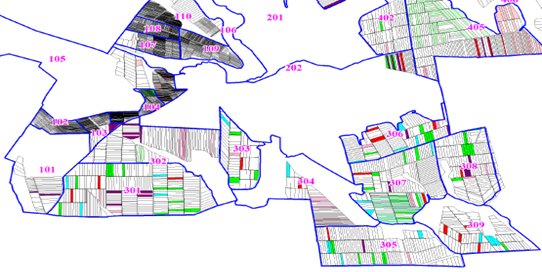eISSN: 2574-9927


Short Communication Volume 7 Issue 2
1Department of Exact Sciences of the Ecology College, Technical University of Moldova, Republic of Moldova
2Technical University of Moldova, Republic of Moldova
Correspondence: Ludmila Ciugureanu, Technical University of Moldova, Department of Exact Sciences of the Ecology College, Chisinau city, Republic of Moldova
Received: March 17, 2023 | Published: April 12, 2023
Citation: Ciugureanu L, Botnarenco I. The role of the territory organization process in the sustainable use of functioning resources. Material Sci & Eng. 2023;7(2):41-42. DOI: 10.15406/mseij.2023.07.00202
The measures, which protect land resources, including agricultural land whose main object is soil, is a highly imported problem worldwide. In un committees and meetings, a topic of discussion is the issue of sustainable use and protection of land resources. Agrarian policy in the EU is also oriented towards the sustainable use of natural resources, the protection of land resources, soil resources, etc.
The Agrarian policy in the Republic of Moldova is the sustainable use and protection of limited land resources. Since 1992, with the implementation of the land reform (transmission of agricultural land to private ownership), an important process in the field of territory organization has been neglected, namely the sustainable use of agricultural land, as well as the application of measures for the organization of the territory.
Keywords: soil, protection, sustainable use, territory organization
Analyzing the history of development of the process of organization of the territory, we realize that the implementation of methodologies for rational (sustainable) use of land resources, including the soil, in all periods, remains a major problem.1
Studying the practical application of the process of sustainable use of land resources in the USA, we can say, that it has a rich experience. The State Commission, created by The President of the Country Bill Clinton, who formulated the Concept of Sustainable Use of Land Resources, based on the concept of land shaft.
If we explain Agrarian policy in the EU, it is also based on a number of principles regarding the sustainable use of land resources, including the application of anti-erosion measures.
Taking into account, that the territory of the Republic of Moldova is largely threatened by the danger of soil erosion, it would be very useful to develop methodologies for sustainable land use. At the beginning of the implementation of the land reform, the territory organization system was destroyed, which led to the lack of a legislative/normative framework in the field, of a methodology for sustainable use of land resources, an institutional system, etc.
Object of the organization of the territory
In the Republic of Moldova, as an object of the territory organization process, are agricultural lands, lands of the forest fund, water fund, etc.
The most important role, as an object of the territory organization process, are the agricultural land and the rotations applied as a methodology.
Land reparcelling – methodology for territory organization
According to Figure 1, the process of territory organization in the Republic of Moldova, unlike other countries, faces the problem of excessive parceling of agricultural land, the one that requires to reclaim land and land rights, by implementing the land consolidation project, which consists in solving the optimization of dimensions, by applying modern technologies of land processing, to achieve high productivity with minimal expense and maintaining or raising the fertility of the soil, to ensure a decent living.2,3

Figure 1 Example of a land settlement plan for exchange (developed within the framework of the land consolidation project).
Through various investments from the EU in the Republic of Moldova, a series of farmland reparcellings have been carried out through land consolidation projects. Currently, 43 land consolidation projects involving 39304 equivalent land elevations have been designed, of which 33 localities are completed, involving 27245 equivalent land quotas. In some cases of implementation of the land consolidation project did not have continuity,4 due to the lack of a well-defined system of territorial organization. The problem turned out to be with a more complicated theoretical and methodological content. of a legislative, methodological, organizational framework,5 the works have been stopped.
Methodological content of the territorial organization project
More and more often, at present, the problem of lack of rotation and the need to implement works, measures for the organization of the territory, land improvements, as well as the lack of a well-defined "Territory Organization System" is specified in Figure 2. The sustainable6,7 use of land resources will be fulfilled, if there is a balanced policy, a "System of Spatial Organization", methodologies for the liquidation of these consequences.
Unlike other fields, the process of sustainable use of land resources is indispensable for the Republic of Moldova, which implies a complex approach to the created problem:
None.
There are no conflicts of interest.
None.

©2023 Ciugureanu, et al. This is an open access article distributed under the terms of the, which permits unrestricted use, distribution, and build upon your work non-commercially.